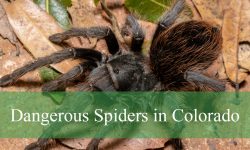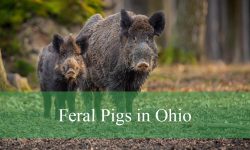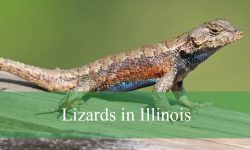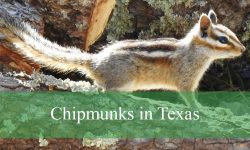Woodpeckers in Minnesota are a familiar sight in forests, parks, and even neighborhood backyards. These unique birds are known for their drumming sounds, sharp bills, and ability to cling to tree trunks. With their bold patterns and interesting behaviors, woodpeckers are favorites among birdwatchers across the state.
Minnesota is home to a variety of woodpecker species, from the tiny downy woodpecker to the impressive pileated woodpecker. Some stay year-round, while others visit during migration. Each species has its own preferred habitat, feeding habits, and appearance, making them exciting to observe and identify.
This guide will help you get to know eight common woodpeckers in Minnesota. You’ll learn how to recognize them by their size, color, and behavior, and discover where you’re most likely to see them. With photos and easy identification tips, this list is perfect for anyone curious about the woodpeckers found in Minnesota.
Types of Woodpeckers in Minnesota
Downy Woodpecker (Dryobates pubescens)

The Downy Woodpecker is the smallest woodpecker species found in Minnesota, measuring only about 5.5 to 6.7 inches in length with a wingspan of 9.8 to 11.8 inches. It has a compact body with a short bill, which sets it apart from similar species. Its plumage is mainly black and white, with a white breast and back, and black wings speckled with white spots. Males are identified by a small, bright red patch on the back of the head, while females lack this marking.
This species is easy to spot due to its preference for open woodlands, residential yards, and city parks. It is a frequent visitor to suet feeders, especially in winter, and has adapted well to suburban environments. Its drumming is light and subtle, unlike that of larger woodpeckers, and it often emits a high-pitched “pik” sound. Downy Woodpeckers are known for their energetic, acrobatic movements as they search for food on tree branches.
Their diet primarily consists of insects, particularly beetle larvae, ants, and caterpillars, which they extract from tree bark by pecking or probing. They also consume berries, seeds, and sap, making them fairly adaptable in terms of feeding. These woodpeckers may be seen gleaning insects from smaller twigs and stems—something larger woodpeckers cannot do due to their weight and size.
Downy Woodpeckers are permanent residents across Minnesota, from the northwoods to urban neighborhoods. They nest in cavities, usually in dead trees or limbs, which they excavate themselves. These cavities are often reused in following years. Their widespread presence and gentle habits make them a favorite among birdwatchers throughout the state.
Hairy Woodpecker (Dryobates villosus)

The Hairy Woodpecker is a larger and more robust cousin of the Downy, measuring between 7.1 and 10.2 inches in length with a wingspan reaching up to 16 inches. Though nearly identical in plumage, it can be distinguished by its longer, sharper bill and the lack of black spots on the white outer tail feathers. Males also have a red patch on the back of the head, like the Downy.
This woodpecker favors mature forests, particularly those with abundant dead trees or snags, but it is also found in wooded suburbs and parks. Hairy Woodpeckers are less likely to visit feeders than Downies, but during cold Minnesota winters, they may be seen at suet feeders. Their drumming is louder and more forceful, used both to communicate and to forage for food in deeper layers of bark.
Their primary diet includes wood-boring insects, ants, and larvae, which they extract from beneath tree bark using their powerful, chisel-like beak. They also consume nuts, berries, and occasionally sap. This species forages more methodically than the Downy, often climbing tree trunks in a straight path as it searches for prey.
Hairy Woodpeckers are year-round residents in Minnesota and occur throughout the state, especially in heavily forested regions. They nest in tree cavities, often choosing higher elevations in large trunks. Their reliance on dead or dying trees for nesting and feeding makes them a key species for monitoring forest health in Minnesota ecosystems.
Red-bellied Woodpecker (Melanerpes carolinus)

The Red-bellied Woodpecker is a striking medium-sized bird, around 9.4 inches long with a wingspan of up to 16.5 inches. Its name is somewhat misleading, as the red tint on its belly is faint and often obscured. The more noticeable feature is the bright red crown and nape, particularly prominent in males. The back is adorned with a bold black-and-white zebra-like pattern, which makes it quite eye-catching.
This species is commonly seen in southern and central Minnesota, especially in hardwood forests, river valleys, and suburban woodlots. Red-bellied Woodpeckers have adapted well to human presence and frequently visit bird feeders for suet, peanuts, and sunflower seeds. They produce a loud, rolling “churr” call and are also known for their drumming on metal objects like gutters or poles, especially in spring.
Red-bellied Woodpeckers are omnivores, feeding on a wide range of insects, spiders, fruits, nuts, and even small vertebrates. They are adept at catching flying insects in midair and may also store food in bark crevices for later consumption. Their long, barbed tongue helps them probe deeply into crevices to extract hidden prey.
These woodpeckers are permanent residents in Minnesota’s southern counties and are gradually expanding northward as temperatures warm. They excavate nest holes in dead trees or limbs, sometimes reusing the same site for several years. Their adaptability and striking appearance make them a standout species in Minnesota’s bird community.
Northern Flicker (Colaptes auratus)

The Northern Flicker is one of the most distinctive woodpeckers in Minnesota due to its unique coloration and ground-feeding habits. It is a large woodpecker, measuring 11 to 12.2 inches long with a wingspan of up to 20 inches. Its plumage includes a tan or brown body with black spots on the belly, a black crescent on the chest, and bright yellow underwings and tail feathers in the eastern “Yellow-shafted” form common in Minnesota.
Northern Flickers prefer open woodlands, forest edges, and suburban areas, where they are often seen foraging on the ground—unusual behavior for a woodpecker. They primarily feed on ants and beetles, using their long, slightly curved bill to probe soil and leaf litter. They also eat fruits and seeds, especially in the fall and winter. Their loud, ringing “kleer” call and rhythmic drumming make them easy to detect even when not in sight.
Unlike many other woodpeckers that cling vertically to tree trunks, Flickers often perch horizontally on branches or forage on lawns and forest floors. They have zygodactyl feet like other woodpeckers (two toes forward, two backward), but their behavior is more akin to thrushes or robins when on the ground. Their flight pattern is undulating and buoyant, with visible flashes of yellow.
Northern Flickers are common summer residents throughout Minnesota and breed in a variety of habitats. Most migrate south for the winter, although a few may overwinter in the southern part of the state if food is abundant. They nest in tree cavities they excavate themselves or sometimes use old woodpecker holes, making them important contributors to woodland nesting ecosystems.
Pileated Woodpecker (Dryocopus pileatus)

The Pileated Woodpecker is the largest and one of the most impressive woodpeckers in Minnesota, reaching lengths of 16 to 19 inches and boasting a wingspan of 26 to 30 inches. Its powerful build is complemented by mostly black plumage with striking white stripes running along its face and neck. The bright red crest is a distinctive feature, especially in males, who also have a red stripe on their cheeks. Its bold appearance and loud, resonating “kuk-kuk-kuk” call make it unmistakable in the forest.
This species primarily inhabits large, mature deciduous and mixed forests where it depends on old or decaying trees for nesting and foraging. Although it prefers remote woodlands, the Pileated Woodpecker has become increasingly common in urban forest preserves, larger parks, and wooded suburbs where suitable habitat still exists. It is a cavity nester and requires large dead trees or snags to excavate its sizable nesting and roosting holes.
Pileated Woodpeckers feed mainly on carpenter ants, beetle larvae, and other wood-dwelling insects, which they extract by chiseling deep, rectangular holes into tree trunks and logs. They also consume wild fruits and nuts, especially in colder months. These birds leave behind easily recognizable rectangular cavities in wood, often surrounded by scattered wood chips—clear signs of their presence and foraging activity.
In Minnesota, Pileated Woodpeckers are year-round residents throughout forested regions, especially in the northern and central parts of the state. Their need for extensive forest habitat means they are not found in open areas or agricultural lands. Their size, strength, and powerful drumming play a vital role in forest ecology, as their abandoned cavities are later used by other birds and mammals for shelter and nesting.
Red-headed Woodpecker (Melanerpes erythrocephalus)

The Red-headed Woodpecker is one of the most visually striking birds in Minnesota, with its brilliant crimson head, snow-white body, and contrasting black back and wings, accented by large white wing patches. This medium-sized woodpecker measures about 7.5 to 9.1 inches long with a wingspan of 16 to 17 inches. Adults are easily identified by their vibrant coloration, while juveniles display a more muted, brownish-gray head until they mature.
These woodpeckers prefer open woodlands, oak savannas, river bottoms, and dead tree stands, particularly in southern and western Minnesota. They can sometimes be seen in parks and golf courses with scattered trees. Red-headed Woodpeckers are notable for their highly active behavior—they catch flying insects mid-air, forage for insects on tree bark, and often store food like nuts and beetles in crevices, under bark, or even in fence posts.
Their diet is diverse and includes insects, acorns, fruits, and seeds. They are also known to occasionally eat small birds or bird eggs. Red-headed Woodpeckers are more aggressive and territorial than other woodpeckers, often defending large areas of feeding and nesting territory. Their loud, harsh calls and strong drumming are part of their territorial displays and communication.
While once more widespread, the Red-headed Woodpecker has declined significantly due to habitat loss, particularly the removal of dead trees and snags essential for nesting. In Minnesota, they are primarily found in the southern and western parts of the state, with localized populations. Their declining numbers make each sighting increasingly special and of interest to birders and conservationists alike.
Yellow-bellied Sapsucker (Sphyrapicus varius)
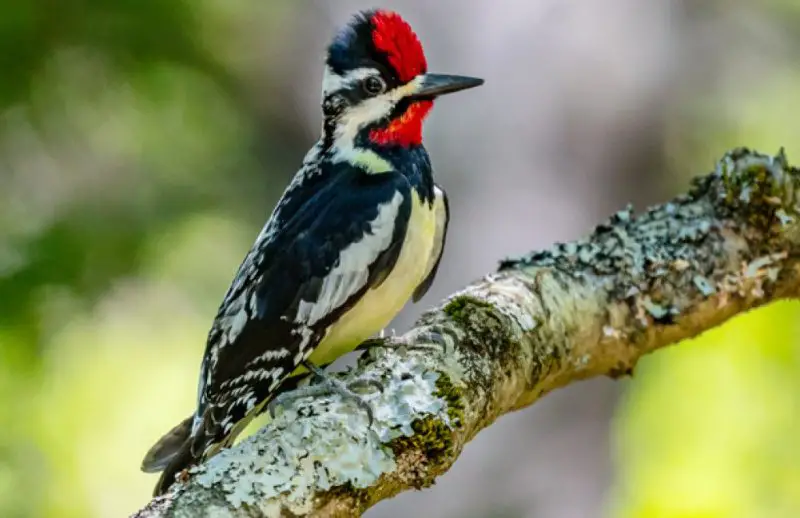
The Yellow-bellied Sapsucker is a small to medium-sized woodpecker, measuring around 7.1 to 8.7 inches long with a wingspan of 13 to 15.8 inches. It is recognized by its pale yellow belly, black-and-white striped face, and a prominent red forehead; males also sport a red throat, while females have a white throat. Unlike other woodpeckers, its plumage is slightly mottled, giving it a more camouflaged appearance against tree bark.
This species is well-known for its unique feeding behavior: it drills precise, horizontal rows of small holes called “sap wells” into tree bark to feed on the sugary sap and the insects attracted to it. These wells are typically found on birch, maple, and aspen trees. Yellow-bellied Sapsuckers use their brush-tipped tongues to lap up the sap, and they frequently revisit the same trees to maintain and harvest their wells.
Their diet includes sap, ants, spiders, caterpillars, and other insects, as well as berries and fruits during migration. Unlike most other woodpeckers in Minnesota, Yellow-bellied Sapsuckers are migratory. They are most visible during spring and fall migration when they pass through the state in significant numbers. During the breeding season, they nest in the boreal and mixed forests of northern Minnesota, often in deciduous trees near water.
In Minnesota, breeding populations are mostly limited to the northern and northeastern forests, though they may appear statewide during migration. Their calls are nasal and mewing, often described as a soft “mew” or “waah,” and their drumming consists of irregular bursts with pauses—a helpful clue for identification. Their feeding habits create sap wells that benefit many other species, making them ecologically important members of the forest community.
Black-backed Woodpecker (Picoides arcticus)
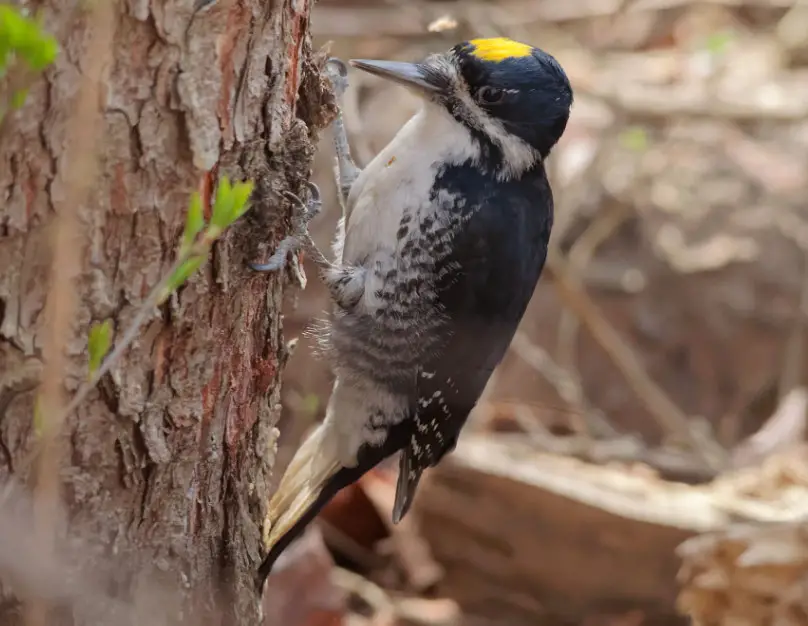
The Black-backed Woodpecker is a rare and elusive resident of Minnesota’s far northern forests, particularly favoring recently burned coniferous woodlands or old-growth stands with extensive decay. Measuring about 9.1 inches in length with a wingspan of 15 to 16 inches, this medium-sized woodpecker is uniquely adapted to post-fire environments. Its appearance is distinctive: an entirely black back, white underparts, and a small yellow crown patch seen only in males. The female lacks this yellow mark, but both sexes share the same bold contrast between dark and light plumage.
The solid black back of this species offers perfect camouflage against charred bark, helping it stay hidden from predators and human observers. Its short tail and three-toed feet (unlike the typical four-toed woodpeckers) assist in climbing and clinging to tree trunks with precision. The facial pattern includes black cheeks and a faint white stripe that extends from the beak below the eye, creating a sharp look that’s well suited for its shadowy habitat. This species is generally silent and secretive, making it a challenge to spot even in ideal locations.
Black-backed Woodpeckers feed primarily on wood-boring beetle larvae and other insects that colonize burned or decaying trees. They use their strong, chisel-like beak to peel bark and excavate soft, rotting wood in search of hidden prey. Their foraging often leaves behind large patches of bark removed from tree trunks, a clear sign of their activity. Occasionally, they may eat fruits or seeds, but insects make up the bulk of their specialized diet.
In Minnesota, they are found mostly in the northernmost regions, especially within Superior National Forest, the Boundary Waters Canoe Area Wilderness, and similar remote areas. They are non-migratory but highly nomadic, sometimes appearing in new burn areas shortly after a wildfire. Their dependence on burned forests makes them an important species in fire ecology, and their presence can indicate a healthy post-fire insect population. Despite their rarity, they play a vital role in the regeneration of forest ecosystems and are a prized sighting for dedicated birders.
FAQ about Woodpeckers in Minnesota
What is the most common woodpecker in Minnesota?
The downy woodpecker is the most common woodpecker in Minnesota. It can be seen year-round in forests, city parks, and even backyard feeders across the entire state.
Which is the largest woodpecker found in Minnesota?
The pileated woodpecker is the largest species in Minnesota. It measures up to 19 inches long and is known for its flaming red crest and powerful drumming.
Are there any rare woodpeckers in Minnesota?
Yes, the black-backed woodpecker is considered rare and elusive. It is mostly found in northern Minnesota, especially in recently burned or decaying conifer forests.
Do all woodpeckers stay in Minnesota year-round?
Not all. While species like the downy, hairy, red-bellied, and pileated woodpeckers are year-round residents, migratory species such as the yellow-bellied sapsucker leave the state in winter.
Can I attract woodpeckers to my backyard?
Yes, many woodpeckers, especially downy, hairy, and red-bellied woodpeckers, visit backyard feeders. You can attract them with suet, peanuts, sunflower seeds, and by preserving dead trees for nesting.
Which woodpecker has a completely red head?
The red-headed woodpecker is the only species in Minnesota with a fully red head. It also has a striking black back and large white wing patches.
Where can I see woodpeckers in Minnesota?
Woodpeckers can be found throughout Minnesota. Some, like the red-headed and pileated, prefer large forests or river valleys. Others, like the downy and hairy woodpeckers, are often seen in backyards and parks.
What do woodpeckers eat in Minnesota?
Minnesota’s woodpeckers feed on a variety of foods including insects, larvae, ants, beetles, fruits, seeds, and tree sap. Some species, like the yellow-bellied sapsucker, drill holes to feed on sap.
Are woodpeckers harmful to trees or homes?
While woodpeckers can occasionally damage wood siding or trees by drilling, they also help control insect populations and provide nest cavities for other wildlife.
When is the best time to see woodpeckers in Minnesota?
Woodpeckers can be seen year-round, though spring and fall are especially good for observing increased activity, drumming, and breeding behavior. Migration periods also bring more visibility for species like the yellow-bellied sapsucker.


